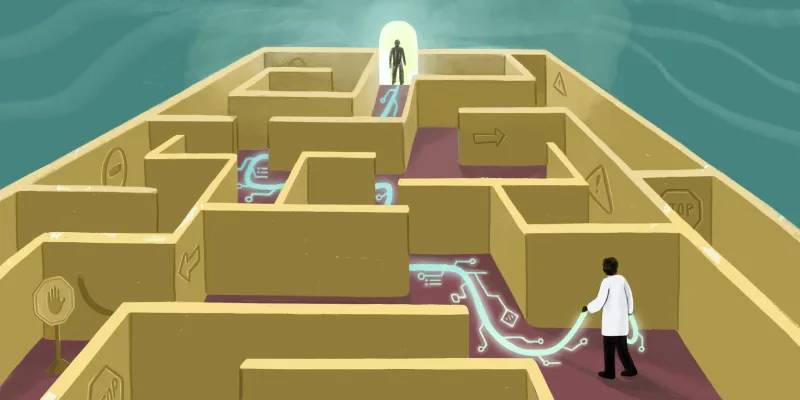It was midnight, and I was still charting. Not because my patients were more numerous or more complex, but because the system demanded it. The EMR, designed to streamline care, had again conscripted my evening, turning documentation into a marathon of clicks, boxes, and endless screens. My fingers hurt from clicking the mouse, my eyes were strained, and I was at risk of making a mistake simply due to the relentless onslaught of words in front of me, combined with the late hour. I found myself longing for the handwritten, elegant, and straightforward SOAP note we all learned in training.
Bringing up the topic of EMRs to clinicians is one of the speediest ways to spark lively and fiery debates, strong opinions, and passionately shared frustrations. The idea and implementation of EMRs has become the medical world’s favorite hot topic, opening the floodgates of conversation and draining vast resources, all in the quest to make this digital tool work for clinicians instead of what the tool does now: driving clinicians to burnout.
Where Did the EMR Come From?
The EMR emerged in 1968 to structure patient data, with the VA pioneering the first integrated system. HL7 standards in the 1980s improved data exchange, while the 1990s brought HIPAA and internet-based EMRs. The 2009 HITECH Act accelerated EHR adoption through financial incentives, reshaping clinical documentation. When the HITECH Act of 2009 and the Meaningful Use program offered incentives for the adoption of certified EHRs, clinicians found themselves working in an entirely new way to document patient care safely and completely.
At the medical center where I worked in the early 2000s, clinicians were required to log into several homegrown systems to find dictated notes, which we would then correct and use to write (or call in) orders and review labs. All triage and consulting communication was done via unsecured email. None of these systems interfaced with one another, but it was a well-intentioned step toward the future. The only communication with patients between visits was by phone or letter.
Many of the original goals, including safer electronic prescribing, accurate billing, and clear communication between clinicians and consultants, have been met. However, in working toward those goals, most EHRs have become overly complex and burdensome to users. While there are certainly successes, there are significant challenges and roadblocks for both clinicians and patients.
The Need for a Clinical Support Team
Writing letters, prior authorizations, and responding to portal messages blur the line between face-to-face patient care and administrative work. Not all clinicians are provided with support to help with this added workload. This can leave the clinician simultaneously dealing with direct patient care and non-face-to-face patient care (through inbox management), with the only way to finish their day’s work being after hours.
Are there cost-effective ways to improve these issues? If when a patient messages about an issue there is no clinical support system in place, the clinician must read the question, respond with a change in the care plan, possibly prescribe a new medication, update the medication list, order follow-up labs, and make a note to follow up, as well as document the entire encounter. All uncompensated and expected by the institution. While this does amount to “free care” (this trend is starting to change as some organizations charge patients for messages that require medical decision-making), it may not be the highest quality of care unless the clinician is exquisitely detail-focused. Sometimes this is difficult to do when it’s midnight and you’re still charting. Many clinicians use the “cut and paste” technique to shorten their charting burden, and this can lead to false documentation, which is a compliance and safety issue for the patient. Practices should clearly define expectations for patient messaging and consider compensating accordingly.
Now, patients have 24/7 access to their clinician via the EMR patient portals, and this can easily be abused. Patient messages and questions must be acted upon quickly; there is an expectation of timely attention, and it is often abused by patients who don’t realize that medical decisions via messaging are less safe and not reimbursed: essentially free care. It is this constant availability that leads to clinician burnout and frustration.
One advertisement for our EMR patient portal portrayed a caricature of a patient lying in bed at an implied late hour, messaging their clinician with their clinical need. No limits, no restrictions, no norms for using this tool. And it is the clinicians who pay the price with the expectation of constant presence and attention.
During the encounter, the EMRs have also changed the relationship between the clinician and the patient. Patients frequently complain that clinicians “type away” at a keyboard instead of looking at and engaging with them during a clinical encounter. This eliminates the face-to-face connection that is vital to the trusting therapeutic relationship, leaving patients feeling unheard and clinicians dissatisfied.
Additionally, in our quest for better EMR systems and processes, we have forgotten the patient who lacks internet or smartphone access. In my practice, this is quite a few people. They are missing appointment reminders, notification updates, overdue medical bills, and lab results.
Thoughtful and intentional creation of interprofessional teams, with all team members working to the top of their scope, is a solution that offers patients more resources rather than placing all the burden on the clinician. For example, schedulers or engagement centers can manage triage messages and consider transforming a complex phone or portal question into a virtual or in-person visit for patient safety. Nurses can respond to messages. They can release normal results to patients through the portal. Medication refills can be "protocolized" for nurses to ease the clinician's prescribing burden, and navigators or panel managers can manage much of the in basket while clinicians provide face-to-face patient care. NPs or PAs can be embedded in triage services to manage issues that require medical decision-making.
The interprofessional team’s collaboration can result in improved outcomes for patients, improved workflow efficiency and communication across disciplines, and a marked decrease in clinician burnout. These teams must be set up intentionally, with frequent checkpoints to be sure that each team member is working to the top of their scope and utilizing their clinical expertise.
The system can backfire. Consider when lab and study results are automatically released to the patient before the clinician has had a chance to evaluate and interpret them. Imagine the very real traumatic scenario of a patient searching online for “words in a radiology report” or discovering a cancer diagnosis from a biopsy result. Sadly, this happens every day.
The 21st Century Cures Act mandated that clinicians' notes must be accessible to patients. This led to transparency tensions: notes once written in medical jargon and designed for communication between clinicians now double as patient-facing documents, which require the translation of medical language and a shift in tone that can dilute clinical nuance. A new and intriguing concept is that of dual-channel documentation, which involves layered notes – one for clinical teams and one for patients. Whatever design is used to improve the EMR in modern care must serve both patients and clinicians.
How Do We Make EMRs Better?
Several recent studies have been published examining the integration of generative AI into the EMR and show that the technology can assist clinicians in crafting more compassionate responses to patient messages or help generate parts of the note while attending to patients.
Additionally, personal input devices such as dictation and voice recognition systems can assist in note documentation, but can be costly for organizations to purchase and maintain. The simple tools embedded in each EMR should be optimized. The day of typing out the whole note has passed. Templates can be set up thoughtfully and organized by visit type or chief complaint. Short “dot phrases” or paragraph templates can be used to write the note, but should always be carefully edited by the clinician. It takes time to set these up, but the benefits seen in use are immense. Elements of the note, including social history, family history, etc., are easily found elsewhere in the record and could be “shrunk” down or eliminated to make the note easier and more concise to read. Clinicians may, however, need to change their personal style with automated AI note creation.
A wise preceptor once told me that he “didn’t want to see a complete sentence in my notes.” His point was well taken: few clinicians have the time to read a long, eloquent or artfully written narrative. Bullets work well, get straight to the point, and still communicate the writer’s assessment and plan to others quickly. Perhaps better.
The topic of EMRs is a multifaceted issue. Patients love it, clinicians are exhausted by the work burden and the bloat of too much information, billing and compliance departments depend on it, and health care systems rely on it to track performance, reduce liability, and secure reimbursement. Clinicians didn’t enter medicine to become data entry clerks. Yet every late-night charting session, every click that distances us from our patients, is a reminder that the system needs to change and evolve. If we want to preserve the heart of health care — human connection, clinical judgment, and compassionate care — we must demand technology that serves us, not the other way around. An EMR is ultimately a tool with many masters – and not all of them wear white coats.
Allison Dimsdale, DNP, is a nurse practitioner in Durham, NC. She enjoys spending time with her children and grandchildren, husband, and ever-changing assortment of rescue hounds. She loves to kayak, and no longer cooks. Allison Dimsdale was a 2024–2025 Doximity Op-Med Fellow.
Image by Irina_Strelnikova / Getty Images







